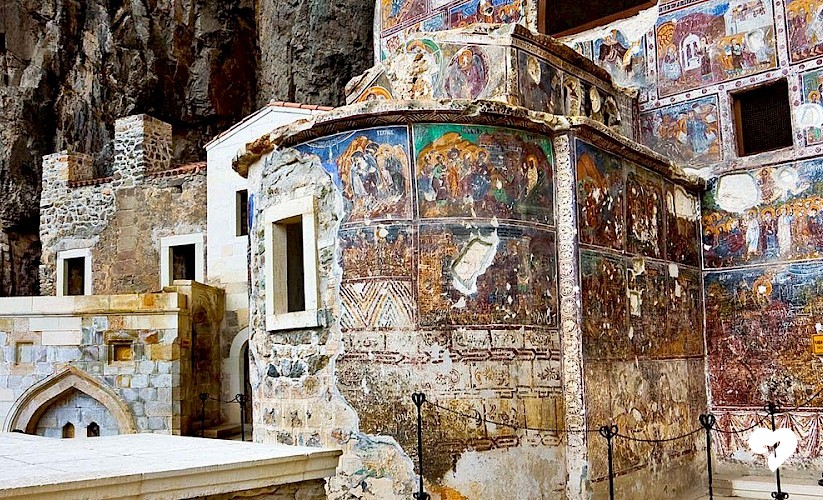Turkey is a home of civilizations, of culture, and of so much more that it’s no surprise that it’s also a home to religions. Some of the earliest churches in the world are in Anatolia, and the original monasteries of many different groups still stand today in their full brilliance.
Architecturally and spiritually, these monasteries are spellbinding remains of an era gone by, and of some of the first Christian communities anywhere in the world.
Sumela Monastery
.jpg)
The first on this list is no surprise, as Sumela is a monastery set in one of the more stunning locations you’ll ever see in any of Turkey’s monasteries. A massive complex cut into the face of the rock, architecturally it’s like nothing you’ve ever seen before.
It underwent restoration recently for a number of years and has only just reopened, meaning that this 4th century monastery is as incredible to visit now as it’s ever been. Even the hike up to the monastery is breathtaking, with views off the cliff down below you.
The main church was formed from a natural cave and built in the shape of an extended apse – truly incredible design. It has frescoes which have also been restored all over, depicting scenes important to eastern Christianity, dating between the 9th and the 19th centuries.
Mor Gabriel Monastery

Mor Gabriel Monastery, or the monastery of St. Gabriel, is the oldest surviving Syriac Orthodox monastery in the world. It was founded in 397 in the beautiful, historic province of Mardin, and by the 6th century was one of the most important monasteries in all of Christianity. Unlike Sumela, it still acts as a monastery today and is the seat of the metropolitan bishop of Syrian Christians of Tur Abdin.
It’s incredible that such a massive complex could really be so old, and you feel the grandeur of its history the second you walk in, as well as when you see the monks and nuns carrying out their practices even up to the present day. A truly amazing experience.
Mor Hananyo Monastery

Mor Hananyo Monastery, also known as the Monastery of St. Ananias, is also located in Mardin, and predictably, it’s also one of the oldest monasteries in the world. Originally a temple to the Assyrian sun god Shamash stood here, but in 493 it was turned into a monastery. Its current form dates mostly back to 793 when it was renovated after having fallen into a state of disrepair.
This monastery was the seat of the Syriac Orthodox patriarch for around 800 years, and even the mountains around it look spiritual as they have holes and caves all across them. These caves were used for hermits who thought the monastery itself wasn’t remote enough, and the monastery provided sustenance and care to those who went to live in them.
It has 365 rooms, one for each day of the year, and the liturgical tongue of the monastery is still Aramaic, the language of Jesus, making Mor Hananyo one of the only the places in the world where Aramaic still lives.
Services are still held every day, and you’ll find a 300-year-old Bible, a 1000-year-old baptismal font, and a 1600-year-old mosaic floor in the main chapel.
Monastery of Mor Augin
Monastery of Mor Augin, also known as the Monastery of St. Augin, is one of the only Coptic monasteries found in Turkey, though even it now operates as a Syriac Orthodox Monastery despite having been founded by a Copt. It was founded in the mid-4th century and is another of the amazing monasteries to be found in Mardin.
The monastery was reopened in 2010, and as renovations continue you can see more and more of how beautiful this ancient monastery really is.
The monastery is dedicate to saint Augin, who is considered traditional founder of Syriac monasticism. He’s called “The Second Christ” in Syriac tradition and his relics are found in this monastery to this day.
Vazelon Monastery

Vazelon Monastery was one of the wealthiest monasteries in all of Anatolia at its peak, and it’s worth visiting for its incredible frescoes alone.
It was originally built in 270 AD, making it another of the oldest monasteries in the world, though little of its current form dates from that period, most of which date to 1410. The monastery no longer serves as an operating monastery but is open for visitation as a tourist sight and its setting and stung frescoes make it well worth the visit 40 kilometers south of Trabzon.
